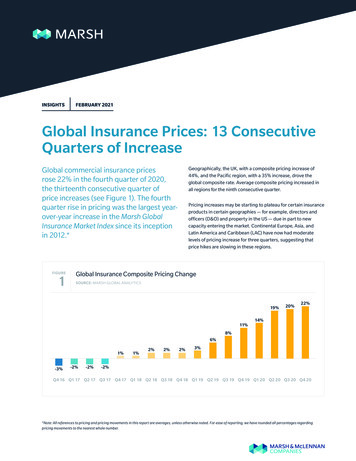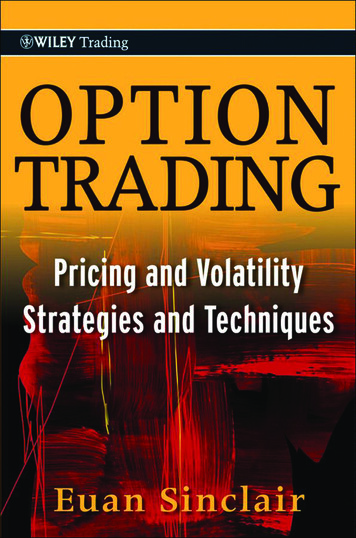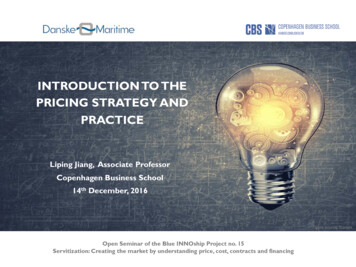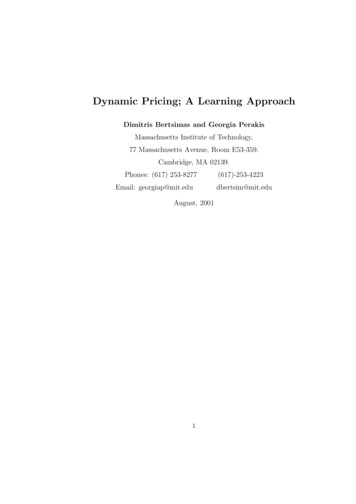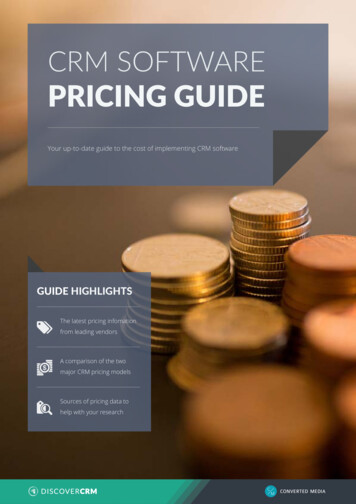
Transcription
Global Pricing Strategiesfor PharmaceuticalProduct LaunchesPeter J. R ankin, Associa te PrincipalGr e g or y K. Bell, Gr oup V ice Pr esidentTim W ilsdon, PrincipalChapter 2 of The PharmaceuticalPricing CompendiumA Practical Guide to the Pricing and Reimbursement of Medicineswww.pharmaceuticalpricing.com
Article SummaryThis article provides a brief strategic overview of thetypes of constraints that manufacturers must overcome inorder to implement a successful global product launchand determine the optimum price.K EYWORDSDemand Analysis, Global Launch, Health Outcomes,Market Research, Optimal Price, Parallel Trade,Prescribing Patterns, Reference PricingESCALATING HEALTHCARE COSTS, increasingsophistication of insurers and regulators, and heightenedinvestor expectations continue to compel pharmaceuticalmanufacturers to become more effective at pursuing allavailable sources of revenue. These pressures are emerging globally, with countries seeking a variety of concessions from pharmaceutical manufacturers. Effective global launch of a new pharmaceutical therapy must accountfor reduced pricing freedom and a tangle of country-specific regulations. Efforts to rationalise regulatory regimesand promote international trade further contribute to anenvironment in which pharmaceutical manufacturersmust manage product launches globally in order to meetrevenue and profit expectations.There are many rewards to reap from effective globallaunches, but today’s approach requires strategic considerations that might differ fundamentally from past experiences. Successful global strategies must negotiate profitable prices in a fragmented and idiosyncratic environment, predict proper launch timing, mitigate parallelimport losses, minimise the effects of reference-basedpricing, and establish consistency in pricing and reimbursement levels across markets and time. An acknowledged effective approach to global launches allows thedevelopment of potentially valuable global brands, generates in-licensing opportunities and maximises global profits.launches. Others include price maintenance, unilateral regulatory price changes, managing price negotiations, andsequential launch timing. Underlying all of these constraints is the spectre of parallel imports, which can magnify the scope of price concessions by eroding sales inprofitable markets.D ETERMINING Demonstrate the clinical attributes of the therapyagainst products Protect against the possibility of a generic or newcompetitive entry Incorporate each country’s healthcare system andphysician prescribing patterns Cater to country-specific regulatory environmentswhile successfully negotiating profitable prices.Price determination should be the culmination ofdemand analysis based on market research, account segmentation, health outcomes analysis and evaluation ofregulatory constraints. The significance of different determinants of launch prices varies by geography; emphasison health outcomes analysis and the risks of parallel tradeis pronounced in Western Europe whereas the importance of managed care and account segmentation analysisis dominant in the US. Figure 2.2 provides a summary ofthese pricing factors, each of which is described in detailbelow.Figure 2.1 - Strategic considerations for global product launchPharmaceutical companies pursuing global productlaunches have identified a troubling tension between minimising the time to market and maximising prices thatdetermine global profits. Limited intellectual propertyprotection and stockholder expectations (among otherfactors) often suggest that the best product launch strategy is one that provides the fastest commercialisation. Thismindset is appropriate in countries where manufacturersare free to set price; however, in countries that requireprice negotiations before launch, such haste to enter themarket risks sacrificing significant revenues over the product life cycle.Of course, this tension is merely the first of many hurdles faced by manufacturers pursuing global product1THE GLOBAL LAUNCH STRATEGYA successful global launch strategy includes far more thandetermining price. As shown in Figure 2.1, the typicallaunch issues, including product positioning, price determination and reimbursement negotiations, must includean evaluation of the factors that affect the launch and lifecycle of the new therapy. For example, a profitable globallaunch strategy must:Source: CRA
Figure 2.2 - Determining optimal global priceof therapy begins in the hospital). Further, the reimbursement decision allows differential support across therapies;not only can a payer exclude some drugs from consideration, but that payer can also demonstrate preferencesamong covered drugs by altering the degree or ease ofreimbursement, as is the case with multi-tiered formularies in the US.Source: CRAPatients can play a significant role in the prescribing decision, especially for certain types of therapies under certain healthcare systems. Granted, patients often defer totheir physicians when considering therapeutic options, butwith the increase in ‘lifestyle’ products, the broader availability of health information and direct-to-patient marketing initiatives, patients increasingly express a preferencefor a particular therapy. In certain markets (e.g., the US),patients also have a direct financial incentive to guidetheir drug decisions, as cost-sharing requirements canresult in higher costs for certain therapeutic options.D EMANDP RICEANALYSISUnderstanding the dynamics of prescription use is ofcritical importance to developing an optimal pricing strategy. Across different countries and physician types, thepropensity to use a particular therapy and, as a result, thewillingness to pay for a therapy, vary greatly. Demandanalysis focuses on three critical questions: Who are the key decision makers for the use of thistherapy? How do the price sensitivities of key decision makersaffect use? How do prescribing preferences vary across marketsof interest?K EYDECISION MAKERSA fundamental truth underlies all prescriptions and provides constancy when considering global product launch:physicians know which therapeutic options are best fortheir patient. Provided a new pharmaceutical offers clinical advantages relative to current treatment methods,physicians, especially key opinion leaders, will motivateprescriptions, both through their own prescriptions forthe product as well as their recognition of clinical advantages in public forums. Manufacturers emphasise theimportance of a new therapy by recruiting key opinionleaders for clinical trials and health outcome analyses toboost the credibility and distribution of information related to their new therapy.Payers affect therapeutic choice in a less direct but oftenmore substantial manner: by limiting the class of optionsfrom which a physician can select a therapy. Some payersmay not reimburse certain products, or might reimburseonly under certain circumstances (such as when a courseSENSITIVITIESAs noted above, key decision makers might be priceinsensitive, depending on the regulatory structure of themarket. Some countries, such as Japan, have regulatorysystems that provide economic incentives for physiciansto use certain therapies. Some European markets discourage physicians from higher priced therapies by establishing physician budgets for prescriptions. Similarly, countries vary greatly in the degree to which patient price sensitivity is encouraged or structured in local regulations.Payer price sensitivity, of course, is a redundant phrase aspayers are universally interested in methods to reduceprices. Pharmaceutical managers should have a firmunderstanding of the local dynamics among these threeparties when establishing a launch strategy. Integrating theresults of these analyses would reinforce a tailoredapproach to maximise returns.P RESCRIBINGPATTERNS ACROSS MARKETSPrescription patterns vary widely across markets, reflecting local epidemiology, physician preferences, clinicalpractices and regulation. Clinical guidelines, guided largelyby these local matters, play a large role in influencing prescribing patterns. Countries often have clinical groupsthat establish treatment guidelines for certain maladies orfor certain classes of pharmaceuticals. These guidelinestypically encompass more than a single product, whichresults in a new product being classified relative to existing comparable therapies. These guidelines can differ significantly across markets. German physicians, for example, are much more willing to use beta-blockers for congestive heart failure than physicians in other Europeanmarkets. In nearly all markets, including Germany, usageof beta-blockers lags behind the targeted rate established2
in clinical guidelines. Which guidelines are followed, theextent to which guidelines encourage the use of particularproducts and the speed with which guidelines are adoptedprovide significantly different prescription patterns acrosscountries.M ARKETRESEARCH : IDENTIFYING THE DEMAND FORPHARMACEUTICALSThe goal of demand analysis is to craft a research agendathat speaks to all three research questions, while also providing insight into segmentation and health outcomestrategies. Market research provides the raw informationto address these concerns, but only if designed well andfielded correctly. Effective market research must provideinformation on all key decision makers. In general, marketresearch should evaluate the share response to changes inthe status of competing products; the share response toclinical attributes, indications, efficacy and patient profiles;price responsiveness; physician response to financialincentives and disincentives for prescribing; and patientawareness and willingness to pay.The particular market research design used to providecompetitive information for a new product launchdepends greatly on the therapy, existing and expectedcompetitors, key decision makers and clinical factors.However, there are a number of practical suggestions thatapply to market research in general. First, key decisionmakers must be placed in realistic trade-off situations.Not only does this provide the most accurate forecast ofmarket demand, but it also keeps the respondent engagedin the survey process. Physicians asked to consider anunfeasible collection of product attributes, or patientsasked about their willingness to pay an exceptionally highcost, are likely not only to provide poor responses, buttheir frustration regarding poor scenario construction willmost likely limit or reduce the quality of informationcollected.Second, market research should consider multiple factorsof demand for a new therapeutic agent. When key decision makers - whether physician, patient or payer - areconfronted with a shortlist of demand determinants, market research is easily manipulated to fulfill the preferencesof the respondent. For example, if market research onpricing a new therapy considers only the effect of price,respondents to market research have an incentive to overstate their price sensitivities in order to encourage lowprices. Instead, pricing scenarios should be coupled withother demand factors, including reimbursement issues,treatment regimens, patient severity and characteristics ofavailable alternatives. The particular type of marketresearch employed (e.g. monadic, discrete choice) can alsoaffect the extent to which respondents can manipulatemarket research to bias the results.3Finally, the third characteristic of effective marketresearch is short, focused survey instruments. The instrument needs to focus on the ‘need-to-know’ issues (identified earlier in the analysis of strategic options for thelaunch) and not be hijacked to satisfy a myriad of ‘niceto-know’ questions. There is an implicit trade-off whenconsidering the length of a survey instrument: collectingmore data from each individual respondent risks respondent fatigue against the higher cost of a larger sample size(the ‘no data versus bad data’ scenario).Armed with effective market research data, manufacturerscan understand the dynamics of prescription patterns fora new product and its competitors. Market research allowsconstruction of share, revenue, profit-maximisation andcompetitor-reaction curves for each global market andmarket segment. The results of market research analysiscan be evaluated at the subgroup level to inform segmentation analyses and health outcome trial designs, andaggregated across groups to the national or pan-Europeanlevel.A CCOUNTSEGMENTATIONA fundamental first step in determining an optimal priceis to prioritise the opportunities available from those whomight purchase or use the therapy, including patients,physicians and payers. Not all purchasers will have thesame sensitivity to price, and not all will purchase similarvolumes. The goal of an optimal pricing strategy is toaccurately predict the price sensitivity, willingness to payand expected purchase volumes of customer groups.Effective segmentation analysis will answer four questionsacross the global customer population: Which segments of the market are price sensitive? How price sensitive are these segments? What percentage of the total market do price-sensitive segments represent? How will competitor responses vary by segment?Segments can be defined using a number of criteria, suchas cost-sharing liability, disease status, physician type,acute/chronic disease type, payer size and predispositionto generic use, among others. There is no single correctmethod to segment the market, as the appropriate tacticwill depend on market and product characteristics. To besuccessful, though, a segmentation method must producesegments that are homogeneous within and heterogeneous among. Once these categories of purchasers havebeen defined, pre-launch efforts and strategic focusshould obviously be directed to those segments of thehighest priority, typically those segments that exhibit thegreatest profit potential.
H EALTHOUTCOMES AND PHARMACOECONOMICSThe value of health outcomes and pharmacoeconomicanalysis depends largely on the structure of the localhealthcare system. In countries where governments negotiate reimbursement levels (e.g. France, Spain andAustralia), health outcomes research is essential todemonstrate the cost effectiveness of a new therapy. Incountries where reimbursement is traditionally negotiatedwith non-government payers (e.g. the US), health outcomes analysis has traditionally played a less importantrole (though health insurers in the US increasingly recognise the value of health outcomes research).An effective global launch strategy must incorporatehealth outcomes research. Not only can an effectivehealth outcomes strategy help to demonstrate the efficacyof a new therapy, compelling health outcomes researchcan speed time to market by anticipating the clinical orcost-effectiveness concerns of regulators. To achieve thisend, manufacturers must conduct a basic evaluation ofhealth outcomes needs in the principal countries for commercialisation well in advance of regulatory filing. In fact,clinical trials data used in health outcomes researchshould be structured to include endpoints of interest tocountries of interest. Such anticipatory planning requiresthat manufacturers identify issues and endpoints of interest sufficiently far in advance to structure the clinical trialsto include these endpoints.Such foresight is often elusive, but the pay-off is oftenworthwhile. Anticipatory data collection can obviate theneed for costly follow-up trials. Addressing country-specific concerns in advance can avoid costly delays in thetime to market for new product launch or restrictiveproduct labeling. Finally, compelling cost-effectivenessdata can constitute a powerful tool in price and reimbursement negotiations with regulators and private payers.PARALLELTRADEThe risk of parallel trade, not to mention the court ofpublic opinion, requires that a profitable global launchstrategy explicitly consider price differentials across markets. Parallel trade describes the process in which largeprice differences among country markets makes it profitable for an arbitrageur to purchase pharmaceuticals inone country market and sell them in another. Parallelimports are particularly prominent in the EU, where tradeliberalisation efforts have minimised the costs associatedwith trade while disparate regulatory policies have encouraged price differentials across markets. Expected enlargement of the EU will only exacerbate the range of pricevariability.Parallel trade diverts additional product revenues from themanufacturer to those who move the pharmaceuticalsfrom one market to another. Spain is a standard example.Low prices have led arbitrageurs to purchase pharmaceuticals in Spain and export them to countries with higherprices, such as Germany or the UK. In such a transaction,the manufacturer loses the value of the sale in theimporting country, realising only the lower priced sale inSpain.In addition, parallel trade imposes other costs on manufacturers, including market forecasting, liability assessmentand mitigation, and volatile manufacturing requirements.The liability assumed by the manufacturer when a product packaged in one country and distributed in another(which might have a different national language) is oftenunclear, leaving manufacturers to assess and addresspotential claims. Manufacturers must also forecast thesales for both exporting and importing countries in orderto minimise the risk of product shortages or unexpectedproduction runs. Manufacturers can work with local governments to address some of these concerns. For example, some countries are experimenting with ‘clawback’policies intended to recoup some of these profits accruing to parallel traders, but these benefits accrue to payers(or patients) rather than pharmaceutical manufacturers.Understanding the potential effects of parallel trade iscomplicated by several emerging trends. First, the increasingly extensive price negotiation required in some countrymarkets generates uncertainty regarding the eventual priceband for the new product. More troubling is that manycountries use reference pricing policies, which potentiallyincreases the number of markets from which paralleltrade exports could ensue by basing reimbursement oncountries with the lowest prices/reimbursement levels.Each of these issues is now explored in detail.P RICENEGOTIATIONSA stark and immediate consideration for pharmaceuticalmanufacturers used to launching pharmaceuticals in theUS, UK or Germany is that few other global marketsallow free pricing. Instead, there is often a period of timebetween regulatory or technical approval and commercialisation, during which manufacturers negotiate with regulators to establish the price at which the new product willbe marketed, or at least reimbursed.Price negotiations are often protracted. In France, pricenegotiations have an average duration more than twicethat for the rest of Europe. In addition to price, thesenegotiations might also require other concessions bymanufacturers. In the UK, for example, manufacturers areconstrained by a specified level of profitability. Othercountries, such as Spain, require manufacturers to committo predetermined sales targets. Manufacturers are heldaccountable for recouping the cost of sales that exceed4
volume commitments, either by reducing prices or bydirectly paying back profits.There are well-documented cases of manufacturers rushing negotiations in order to launch as quickly as possible,only to realise that the gains from a quick commercialisation did not outweigh the cost of reduced reimbursementlevels resulting from abbreviated negotiations. Clearly,manufacturers must approach these negotiations with careand careful preparation. Quick commercialisation is notalways ruled out, however. In some countries, such as theUK and France, effective strategies often hasten negotiations not by acceding to price reductions, but instead byagreeing to labeling and use limitations on their products.Once a quick launch is achieved, at a favourable reimbursement rate, subsequent clinical trials can expandproduct labeling. Manufacturers anticipating this strategycan even prepare the subsequent clinical trial frameworkbefore negotiations begin.R EFERENCEPRICINGThe concentration of purchasing power to payers (oftengovernment agencies) in global markets is of little consequence to optimal pricing without other regulatory constraints. As has become well publicised, though, manyregulatory agencies have pursued a host of methodsintended to limit the prices that a pharmaceutical manufacturer can charge. One example of these policies is reference pricing. Under a reference pricing framework theprice of a pharmaceutical therapy is affected by the priceof a reference drug. The reference product might beanother drug in the same therapeutic class; it might be adrug with the same clinical indications; and it may or maynot be available in the country of interest. Canada, forexample, sets drug prices by comparing with pricescharged for that drug in the US and several Europeancountries. Australia exercises firm reference pricing withreimbursements capped at the reference price.Reference pricing has two immediate effects on pricingfor product launch. First, some countries are consideringa form of retroactive reference pricing, which would constrain a manufacturer’s ability to use launch timing andlife-cycle pricing changes to maximise profits. Second, theexistence of reference pricing policies ‘ups the ante’, orincreases the pressure on pharmaceutical manufacturersto avoid selling at a low price, as that low price could beused to affect pricing in other countries that use referencepricing. The strategic implications of both effects areexplored below.R EFERENCEPRICING EFFECTS ON TIMING DECISIONSRetroactive reference pricing may place further restrictions on pricing strategy, limiting some of the rationalethat used to support a sequential entry strategy for a5global launch. Unless a sequential strategy is mandated byregulatory requirements, intellectual property concerns, orproduction or distribution capacity constraints, retroactivereference pricing can limit the cost of an immediate rollout in every market of interest. For a country that practises retroactive reference pricing, a subsequent launch inanother country at a lower price may force the manufacturer to reduce the price in the first country and refundthe difference between the price charged initially and thenew, lower price.R EFERENCEPRICING EFFECTS ON PRICING STRATEGYIn completing regulatory dossiers to seek clinical or technical approval in global markets, manufacturers oftenhave the opportunity (and perhaps obligation) to reportthe anticipated prices, sales volumes, reference productsand clinical indications of their therapy. There are obvious strategic issues inherent in the approach taken inthese dossiers, where manufacturers have the chance toaffect regulatory consideration of their therapy. Whilethese dossiers are usually country specific, they oftenshare a core of information (such as clinical trials data)that is common across countries. The extent to whichclinical trials and health outcomes analysis anticipatesglobal launches and incorporates this information into thestructure of the studies (e.g. trial location and demographic populations, or health outcome endpoints of particular interest) will affect the latitude enjoyed by themanufacturer in addressing idiosyncratic concerns ofindividual regulators.Pharmaceutical manufacturers have two strategic choicesaffected by reference pricing, assuming that the necessaryclinical and regulatory information is available. First, manufacturers can choose a limited number of countries inwhich they would like to commercialise their product.Because of reference pricing, it might be a (global) profitmaximising strategy to avoid launching a product in certain countries. For example, several manufacturers haveavoided commercialising a product in France, both inrecognition of the protracted length of negotiations andthe possibility of a low reimbursement price triggeringlower prices in other markets that use reference pricing.The second strategic option available to manufacturers isto craft a globally consistent price negotiation strategy.The most commonly cited example of such a strategyinvolves the use of price bands.P RICEBANDSPrice bands define the allowable difference in pricesacross global markets. As depicted by the hypothetical situation in Figure 2.3, the narrowest price band is a singleprice charged in all markets. Such a price eliminates theconcern of reference pricing, but also restricts a
While they provide a useful heuristic tool for the evaluation of pricing strategy, price bands face limitations. Thedegree of success attainable from a price band strategydepends on the willingness of a manufacturer to walkaway from reimbursement discussions that do not complywith the global strategy. In a manufacturer’s favour, ademonstrable price band strategy might provide supportfor requested prices in reimbursement discussions. Just aslikely, however, a price band strategy increases the relevance of each negotiation, effectively increasing the bargaining power of regulators, many of whom already enjoysignificant advantages as near-monopoly purchasers.Figure 2.3 - Price bands: no variationPrice at 11.55 acrossEU yields 162.77 profit 45GermanyFrance 35ProfitUKSpain 25Italy 15Figure 2.4 - Price bands: increasing price discrimination15% price band increasesprofit to 166.54 45GermanyUKSpain 25 12 14 16 18Parallel trade risk lowest with single price and no price discriminationSource: CRACertainly, parallel trade is not only an issue under a priceband strategy; after all, parallel trade will develop whenever there is a sufficient price differential among markets,whether the result of a price band strategy or not. In fact,it is the price differential between markets encouragingparallel trade that places an upper bound on the potentialsuccess of a price band strategy. Of course, referencepricing will magnify the consequences of any sub-optimalresult of pricing negotiations by increasing the number ofmarkets from which parallel trade exports could ensue.Italy 15 5 10 12 14 16 18Parallel trade likely but with potential higher profitSource: CRAC ONCLUSIONManufacturers that have grown accustomed to the pricingfreedom afforded by certain markets such as the US arelikely to encounter severe strategic challenges whenattempting a global product launch. Price restrictions,including reference pricing, profit limits, price reductionsand other measures combine to create a global marketwith price constraints growing increasingly numerous.Launching in any country may have immediate ramifications in other countries, and unfortunate pricing decisionscan spread to several markets despite the best efforts ofthe manufacturer. In this increasingly complex globalmarketplace, manufacturers must use segmentation analysis, health outcomes research, parallel trade evaluation anddemand analysis to craft a coherent global pricing strategythat anticipates regulatory entanglements. While difficult,the profits of an effective comprehensive global launchstrategy more than justify a concerted strategic effort.A BOUT 5 10France 35Profitmanufacturer from realising the highest global profit levels. For instance, in Figure 2.3, the single price is too highto maximise profits in Spain and too low to maximiseprofits in Germany (the profit-maximising price corresponds to the highest point on the profit curves ofFigure 2.3 for each country). Alternatively, wide pricebands allow some differences in prices across countries.Such price differences might allow for some negativeeffects due to parallel trade or reference pricing, but theyalso provide additional latitude to reach the profit-maximising price in more markets. Figure 2.4 demonstratesthat a 15% price band would allow a manufacturer inthese circumstances to charge a different profit-maximising price specific to each of the five country markets.THE AUTHORSPeter J. Rankin, PhD, is an Associate Principal in thePharmaceuticals Practice (Washington, DC).Tel: 1 202 662 3935; email: prankin@crai.comGregory K. Bell, PhD, MBA, is a Group Vice Presidentand the Pharmaceuticals Practice Leader (Boston).Tel: 1 617 425 3357; email: gbell@crai.comTim Wilsdon, MSc, is a Principal who directspharmaceutical projects in Europe (London). Tel: 44 20 7664 3707; email: twilsdon@crai.co.uk.This article originally appeared in The Pharmaceutical PricingCompendium—A Practical Guide to the Pricing andReimbursement of Medicines. Reprinted with the expresspermission of Urch Publishing who owns the copyright.6
A BOUT C HARLES R IVER A SSOCIATES ( WWW . CRAI . COM )Founded in 1965, Charles River Associates is an economics, finance, and business consulting firm thatworks with businesses, law firms, accounting firms, and governments to provide a wide range of services.CRA combines economic and financial analysis with expertise in litigation and regulatory support, businessstrategy and planning, market and demand forecasting, policy analysis, and engineering and technology management. In thousands of engagements, CRA has distinguished itself by its corporate philosophy of providing responsive, top-quality consulting; an interdisciplinary team approach; unsurpassed economic, financial,and other analytic skills; and pragmatic business insights.Our business consulting practice provides services directly to companies seeking assistance with strategicissues that require sophisticated economic or financial analysis, and which typically require “mission-critical”decisions for the client, such as positioning and pricing a new product or developing new technologicalprocesses. We apply a highly analytical, quantitative approach, helping compan
ETERMINING THE GLOBAL LAUNCH STRATEGY. A successful global launch strategy includes far more than determining price. As shown in Figure 2.1, the typical launch issues, including product positioning, price deter-mination and reimbursement negotiations, must include an evaluation of the factors that affect

